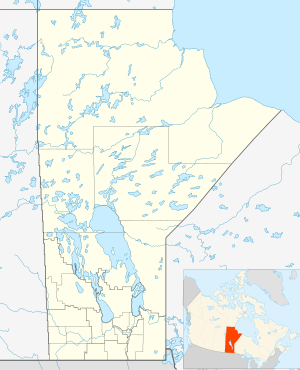Tanco Mine
| Location | |
|---|---|
 Tanco Mine Location in Manitoba | |
| Location | Bernic Lake |
| Province | Manitoba |
| Country | Canada |
| Coordinates | 50°25′48″N 95°26′47″W / 50.4299554°N 95.4464722°WCoordinates: 50°25′48″N 95°26′47″W / 50.4299554°N 95.4464722°W |
| Production | |
| Products | Caesium from Pollucite, Spodumene, Tantalum |
| History | |
| Opened | 1969 |
| Closed | Currently open |
| Owner | |
| Company | Cabot Corporation |
| Website | About the Tanco mine |
Tanco Mine is an underground caesium and tantalum mine, owned and operated by Cabot Corporation on the north west shore of Bernic Lake, Manitoba, Canada.[1] The mine has the largest known deposit of pollucite and is also the world's largest producer of caesium.
History
The pegmatite ore body now mined by the Tanco Mine was discovered in the late 1920s and the first mining started in 1929. Several times the mine was closed, reopened and closed, until in 1969 when it was reopened as a tantalum mine.[1] Cabot Corporation bought the mine in 1993, and began the production of caesium brine from pollucite in 1996.[2] The caesium brine is converted into caesium formate which is used mostly as additive for drilling fluids to increase the fluid's density. A concentrated solution of caesium formate has a density of 2.3 g/cm3.[1]
Geology
The pegmatite found at the north west shore and below the lake floor of Bernice Lake is a granitic igneous rock enriched in the incompatible elements, for example caesium, lithium, tantalum and beryllium. Pegmatite forms if magmatic rock slowly crystallizes, and the incompatible elements are concentrated in the residual molten magma. Examples of minerals found in the mine are the lithium-containing spodumene and amblygonite, caesium-containing pollucite, beryllium-containing beryl and tantalum- and niobium-containing simpsonite and tantalite.[1][3]
Deposit
The pollucite ((Cs,Na)2Al2Si4O12·2H2O) deposit associated with the pegmatite is the largest known deposit of this mineral and with 350,000 tons,[3] it accounts for two thirds of the known resources.[4] With an estimated average global use of 30,000 kg/year the reserves of the mine would last for 2,000 to 3,000 years.[4] The mined pollucite contains approximately 24% Cs2O.[5] The ore body is 1400 m long, 600 m wide and 100 m deep.[3][6] For several decades the pegmatites at Bernic Lake have supplied the world with the needed caesium.[4]
References
- 1 2 3 4 "TANCO — Tantalum Mining Corporation of Canada,Ltd" (PDF). Cabot Corporation. 2001. Retrieved 2009-10-17.
- ↑ "The Tanco Mine". davidkjoyce.com. Archived from the original on 2009-09-30. Retrieved 2009-10-17.
- 1 2 3 Černý, Petr; Simpson, F. M. (1978). "The Tanco Pegmatite at Bernic Lake, Manitoba: X. Pollucite" (PDF). Canadian Mineralogist. 16: 325–333.
- 1 2 3 Butterman, William C.; Brooks, William E.; Reese, Jr., Robert G. "Cesium" (pdf). United States Geological Survey. Retrieved 2009-10-17.
- ↑ Polyak, Désirée E. "Cesium" (PDF). United States Geological Survey. Retrieved 2009-10-17.
- ↑ Kremer, P. D.; Lin, S. (2006). "Report of Activities 2006: Structural geology of the Bernic Lake area, Bird River greenstone belt, southeastern Manitoba (NTS 52L6): implications for rare element pegmatite emplacement" (PDF). Manitoba Geological Survey. pp. 206–213.
Further reading
- Garrett, Donald E. (2004). Handbook of lithium and natural calcium chloride: their deposits, processing, uses and properties. Academic Press. pp. 150–157. ISBN 978-0-12-276152-2.
- National Materials Advisory Board (U.S.). Committee on the Technical Aspects of Critical and Strategic Materials (1983). Tantalum and columbium supply and demand outlook. National Academies. p. 23.